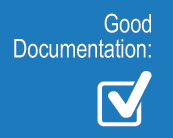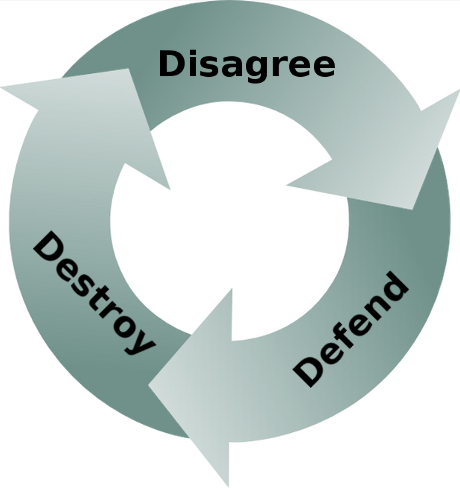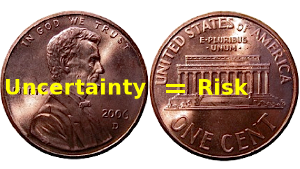 3 of 10 software projects fail, 3 succeed, and 4 are ‘challenged’1. When projects fail because you cut corners and exceed your capabilities then — you get what you deserve. You don’t deserve pity when you do it to yourself.
3 of 10 software projects fail, 3 succeed, and 4 are ‘challenged’1. When projects fail because you cut corners and exceed your capabilities then — you get what you deserve. You don’t deserve pity when you do it to yourself.
We estimate that between $3 trillion and $6 trillion dollars are wasted every year in IT. Most of this is wasted by organizations that are unskilled and unaware that they are ignorant.
Warning this article is long!
However, there are organizations that succeed regularly because they understand development, implement best practices, and avoid worst practices (see Understanding Your Chances).
In fact, McKinsey and Company in 2012 stated:
A study of 5,400 large scale IT projects finds that the well known problems with IT Project Management are persisting. Among the key findings quoted from the report:
- 17 percent of large IT projects go so badly that they can threaten the very existence of the company
- On average, large IT projects run 45 percent over budget and 7 percent over time, while delivering 56 percent less value than predicted
 Projects fail consistently because organizations choose bad practices and avoid best practices and wonder why success is elusive (see Stop It! No… really stop it. to understand the common worst 5 practices)
Projects fail consistently because organizations choose bad practices and avoid best practices and wonder why success is elusive (see Stop It! No… really stop it. to understand the common worst 5 practices)
What is amazing is that failures do not prompt the incompetent to learn why they failed.
 Even worse, after the post-fail finger pointing ceremony, people just dust themselves off and rinse and repeat.
Even worse, after the post-fail finger pointing ceremony, people just dust themselves off and rinse and repeat.
The reality is that we have 60 years of experience in building software systems. Pioneers like Watts Humprey, M.. E. Fagan, Capers Jones, Tom DeMarco, Ed Yourdon, and institutions like the Software Engineering Institute (SEI) have demonstrated that software complexity can be tamed and that projects can be successful2.
The worst developers are not even aware that there is clear evidence about what works or what doesn’t in software projects. Of course, let’s not let the evidence get in the way of their opinions.
 Ingredients of a Successful Project
Ingredients of a Successful Project
Successful software projects generally have all the following characteristics:
- Proper business case justification and good capital budgeting
- Very good core requirements for primary functionality
- Effective sizing techniques used before executing the project
- Appropriate project management to the size of the project and to the philosophy of the organization
- Properly trained personnel
- Focus on pre-test defect removal
 Every missing characteristic reduces your chance of success by an order of magnitude. If you know that one or more of these characteristics are missing then you get what you deserve!
Every missing characteristic reduces your chance of success by an order of magnitude. If you know that one or more of these characteristics are missing then you get what you deserve!
Missing some of these elements doesn’t guarantee failure, but it severely decreases your chance at success.
Let’s go through these elements in order.
This article is very long, so this is a good place to bail if you don’t have time.
Proper Business Case
 This is the step that many failed projects skip over, the hard work behind determining if a project is viable or not.
This is the step that many failed projects skip over, the hard work behind determining if a project is viable or not.
Organizations take the Field of Dreams approach, i.e. “If you build it, they will come...” and skip this step due to ignorance, often resulting from executives who do not understand software (see No Business Case == Project Failure). These are executives that do not have experience with software projects and assume that their force of personality can will software projects to success.
Some organizations claim to build business cases, but these documents are worthless. I even know of public companies that write the business case AFTER the project has started, simply to satisfy Sarbanes-Oxley requirements.
A proper business case attempts to quantify the requirements and technical uncertainty of a software project. It does due diligence into what problem is being solved and who it is solving the problem for. It at least verifies with a little effort that the cash flows resulting from the project will be NPV positive.
Business cases are generally difficult to write because they involve getting partial information. This can be very difficult if your analysts are substandard (see When BA means B∪ll$#!t Artist).
Very Good Core Requirements
 Once a project has a proper business case then you need to capture the skeleton of the core requirements. This is a phase where you determine the primary actors of the system and work out major use case names.
Once a project has a proper business case then you need to capture the skeleton of the core requirements. This is a phase where you determine the primary actors of the system and work out major use case names.
Why expand requirements before starting the project?
Executives have a business to run and need to know when software will be available. If you don’t know how big your project is then you can’t create an effective project plan. You don’t want to capture all the requirements so core requirements (i.e. a good skeleton) helps you to size the project without having to get the detailed requirements.
This is why executives like the waterfall methodology. On the surface, this methodology seems to have a predictable timeline — which is what they need to synchronize other parts of the business. The problem is that the waterfall methodology DOES NOT WORK (see last page).
The only way for managers to get a viable estimate of a software project is to expand the business case into requirements that allow you to determine the project’s size before you start it.
 This process is just like determining the cost for a house by the square footage and the quality, i.e. 2500 sq. ft at normal quality (~$200 per sq. ft.) would be approximately $500K, even without detailed blueprints. Very accurate estimates can be derived by sizing a project using function points.
This process is just like determining the cost for a house by the square footage and the quality, i.e. 2500 sq. ft at normal quality (~$200 per sq. ft.) would be approximately $500K, even without detailed blueprints. Very accurate estimates can be derived by sizing a project using function points.
Effective Estimation
 Now that you have core requirements, you can determine the size of the project and get an approximate cost. You are fooling yourself if you think that you can size large projects without formal estimates (see Who needs formal measurement?)
Now that you have core requirements, you can determine the size of the project and get an approximate cost. You are fooling yourself if you think that you can size large projects without formal estimates (see Who needs formal measurement?)
Just like you can determine the approximate cost of a house if you know the square footage and the quality, you can estimate a software project pretty accurately if you know how many function points (i.e. square footage) and quality requirements of the project3.
There is so much literature available on how to effectively size projects, so do yourself a favor and look it up. N.B. There are quite a few reliable tools for an accurate estimate of software projects, i.e. COCOMO II, SLIM, SEER-SEM. See also Namcook Analytics,
If you don’t size a project then your project plan predicts nothing
Of course, you could always try a management declared deadline which is guaranteed to fail (see Why Senior Management Declared Deadlines lead to Disaster)
Appropriate Project Management
 You must select a project methodology appropriate to the organization. Many developers are trying to push their organizations towards Agile software development, although many developers are actually quite clueless about what Agile development is.
You must select a project methodology appropriate to the organization. Many developers are trying to push their organizations towards Agile software development, although many developers are actually quite clueless about what Agile development is.
Agile software development needs buy-in from the top of the organization. Agile software development will probably do very little for you if you are not doing business cases and gathering core requirements before a project.
Discover how developers who claim that they are ‘Agile’ have fooled themselves into thinking that they are doing Agile development. (see Does Agile hide Development Sins?)
Trained Personnel
 Management often confuses seniority with competence. After all, if someone has been with the company for 10 years they must be competent, no? The reality is that most people with 10 years of experience only have 1 year repeated 10 times. They are no more skilled then someone with 1 year under their belt.
Management often confuses seniority with competence. After all, if someone has been with the company for 10 years they must be competent, no? The reality is that most people with 10 years of experience only have 1 year repeated 10 times. They are no more skilled then someone with 1 year under their belt.
Learn why in general it may be useful to get rid of older developers that are not productive (see No Experience Required!). Also when it comes to development, you are definitely better off with people that do not rush to write code (see Productive Developers are Smart and Lazy)
Focus on Pre-Test Defect Removal
I’ve written extensively on pre-test defect removal, see Are Debuggers Crutches? for more information.
Conclusion
It is likely that you know all these ingredients that make for a successful project, you’ve just assumed that even though all these characteristics are not present that you just can’t fail.
Quite often projects fail under the leadership of confident people who are incompetent and don’t even know that they are incompetent. If you want to know why intelligent people often do unintelligent things see Are You are Surrounded by Idiots? Unfortunately, You Might be the Idiot..
There probably are projects that fail out there because of circumstances out of their control (i.e. natural disasters, etc) but in most failed projects you get what you deserve!

Fallacy of the Waterfall Methodology
 The waterfall methodology is widely attributed to Winston W. Royce.
The waterfall methodology is widely attributed to Winston W. Royce.
The irony is that the paper he published actually concludes that:
In my experience, however, the simpler method (i.e. waterfall) has never worked on large software development and efforts and the costs to recover far exceeded those required to finance the five step process listed.
That is Mr. Royce said that the waterfall process would never work. So much for the geniuses that only read the first 2 pages of the paper and then proceeded to create the “waterfall method” and cost organizations trillions of dollars in failed projects each year.
The waterfall methodology was pushed down our throats by ignorant managers that saw that the waterfall seemed to mimic factory processes. Because this was the process they understood, they icorrectly assumed that this was the right way to develop software.
If any of these guys had bothered to read more than 2 pages from the Royce paper they would have realized that they were making a colossal blunder.
Back to article
1 Challenged means that the project goes significantly over time or budget. In my estimation, ‘challenged’ simply means politically declaring victory on a project that has really failed.
2 This applies to projects that are 10,000 function points or less. We still have problems with projects that are larger than this, but the vast majority of projects are under this threshold.
3 Quality requirements depend on how reliable the project must be. If the risk is that someone might die because of a software malfunction the quality, and therefore cost, must be much higher than if software failures only constitute an annoyance.
VN:F [1.9.22_1171]
Rating: 0.0/5 (0 votes cast)
VN:F [1.9.22_1171]
 Connecting with your customers and delivering value depends on understanding your customer’s requirements and selling the correct product or solution that solves your customer’s problems.
Connecting with your customers and delivering value depends on understanding your customer’s requirements and selling the correct product or solution that solves your customer’s problems. The more that product customization or creation is required, the more it is important understand the customer’s actual problem. The more time required to build and implement a solution means will not only lead to a failed sale but also to a more disappointed customer and a loss of future revenue.
The more that product customization or creation is required, the more it is important understand the customer’s actual problem. The more time required to build and implement a solution means will not only lead to a failed sale but also to a more disappointed customer and a loss of future revenue. Time pressures to make a sale put us under pressure and this stress leads to making quick decisions about whether a product or solution can be sold to a customer. We listen to the customer but interpret everything he says according to the products and solutions that we have.
Time pressures to make a sale put us under pressure and this stress leads to making quick decisions about whether a product or solution can be sold to a customer. We listen to the customer but interpret everything he says according to the products and solutions that we have. We hear the word car and we think that we know what the customer means. The order-taker sales person will spring into action and sell what he thinks the customer needs. Behind the word car is an implied usage and unless you can ferret out the meaning that the customer has in mind, you are unlikely to sell the correct solution.
We hear the word car and we think that we know what the customer means. The order-taker sales person will spring into action and sell what he thinks the customer needs. Behind the word car is an implied usage and unless you can ferret out the meaning that the customer has in mind, you are unlikely to sell the correct solution.For products that require customization, the sale will get transferred to professional services that will dig deeper into the customer’s requirements. At this point you discover that the needs of the customer cannot be met. This leads to sales people putting pressure on professional services and product management to ‘find a solution’, after all, losing the sale is not an option.
 Sometimes heroic actions by the product management, professional services, and software development teams lead to a successful implementation, but usually not until there has been severe pain at the customer and midnight oil burned in your company. You can eventually be successful but that customer will never buy from you again.
Sometimes heroic actions by the product management, professional services, and software development teams lead to a successful implementation, but usually not until there has been severe pain at the customer and midnight oil burned in your company. You can eventually be successful but that customer will never buy from you again. Selling the correct solution to the customer requires that you understand the customer’s problem before you sell the solution.
Selling the correct solution to the customer requires that you understand the customer’s problem before you sell the solution.
 Opinions vary on whether a project manager needs to have domain experience. Certainly project managers that do not have domain experience will be the first to say that domain experience is not necessary as long as they have access to excellent subject matter experts.
Opinions vary on whether a project manager needs to have domain experience. Certainly project managers that do not have domain experience will be the first to say that domain experience is not necessary as long as they have access to excellent subject matter experts. I am currently involved in a project that involves a LAN/WAN/WIFI upgrade of a large customer for a large telecommunications company. The project manager does not have domain expertise in networks and is counting on the subject matter experts to provide him sufficient input to execute the project.
I am currently involved in a project that involves a LAN/WAN/WIFI upgrade of a large customer for a large telecommunications company. The project manager does not have domain expertise in networks and is counting on the subject matter experts to provide him sufficient input to execute the project. In the distant past ,I was part of a team that was building a mobile POS terminal that worked over cellular (GSM, CDMA). The project manager in this situation did not have domain experience and was counting on the subject matter experts. In this case, the subject matter experts were very good at general design, but not experts in building cellular devices.
In the distant past ,I was part of a team that was building a mobile POS terminal that worked over cellular (GSM, CDMA). The project manager in this situation did not have domain experience and was counting on the subject matter experts. In this case, the subject matter experts were very good at general design, but not experts in building cellular devices. So if a project does not have many uncertainties and dependencies then it is extremely likely that the project manager does not require domain experience and can rely to some degree on his subject matter experts.
So if a project does not have many uncertainties and dependencies then it is extremely likely that the project manager does not require domain experience and can rely to some degree on his subject matter experts. This is like when
This is like when  The documentation actually helps to understand the program
The documentation actually helps to understand the program The interesting thing is that developers are fairly disciplined about using version control systems, yet there is a complete lack of discipline (in general) when it comes to documentation.
The interesting thing is that developers are fairly disciplined about using version control systems, yet there is a complete lack of discipline (in general) when it comes to documentation. The only time that you are thinking about what you are trying to do is before you have written the code. This is clearly the best time to write the documentation. The problem is that developers move from thinking about how to solve a problem to getting their hands on the keyboard to write code to solve the problem. In the blink of an eye the programmer switches modes and gets caught up in trying to solve the problem.
The only time that you are thinking about what you are trying to do is before you have written the code. This is clearly the best time to write the documentation. The problem is that developers move from thinking about how to solve a problem to getting their hands on the keyboard to write code to solve the problem. In the blink of an eye the programmer switches modes and gets caught up in trying to solve the problem. Good documentation requires just as much (if not more) thinking than what is required to solve the problem. Much of the time people don’t have a good idea of what problem they are solving. By truly spending time on figuring out what you have to solve, then documenting it, sounds like it would take longer — but you will be surprised to find out that this actually saves time.
Good documentation requires just as much (if not more) thinking than what is required to solve the problem. Much of the time people don’t have a good idea of what problem they are solving. By truly spending time on figuring out what you have to solve, then documenting it, sounds like it would take longer — but you will be surprised to find out that this actually saves time.

 If things get out of hand then people start taking sides and productivity takes a major hit. In the worst conflicts this leads to loss of key personnel, which has been measured to be:
If things get out of hand then people start taking sides and productivity takes a major hit. In the worst conflicts this leads to loss of key personnel, which has been measured to be:


 When executives
When executives
















 This process is just like determining the cost for a house by the square footage and the quality, i.e. 2500 sq. ft at normal quality (~$200 per sq. ft.) would be approximately $500K, even without detailed blueprints. Very accurate estimates can be derived by sizing a project using function points.
This process is just like determining the cost for a house by the square footage and the quality, i.e. 2500 sq. ft at normal quality (~$200 per sq. ft.) would be approximately $500K, even without detailed blueprints. Very accurate estimates can be derived by sizing a project using function points.


 The waterfall methodology is widely attributed to
The waterfall methodology is widely attributed to 
 One of the most fundamental issues that organizations wrestle with is
One of the most fundamental issues that organizations wrestle with is  Like defect tracking systems most developers have learned that version control is a necessary
Like defect tracking systems most developers have learned that version control is a necessary  Sorry Version One and JIRA, the simple truth is that using an Agile tool does not make you agile, see
Sorry Version One and JIRA, the simple truth is that using an Agile tool does not make you agile, see  I have written extensively about why debuggers are not the best tools to track down defects. So I’ll try a different approach here.
I have written extensively about why debuggers are not the best tools to track down defects. So I’ll try a different approach here. There is definitely a large set of developers that assume that using a
There is definitely a large set of developers that assume that using a  Learning tools is not a
Learning tools is not a 

 That is why developers that
That is why developers that 
